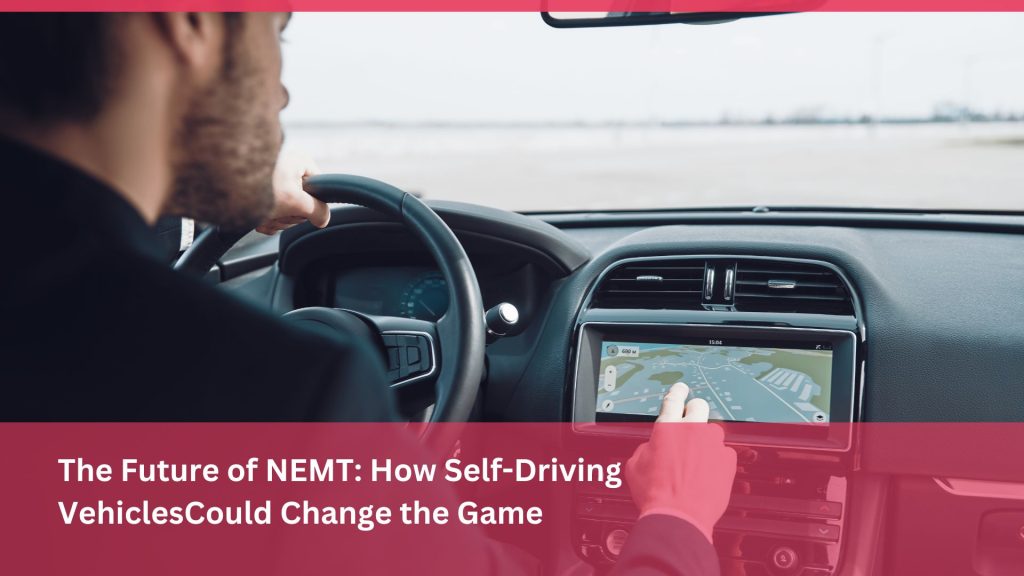New at Safr Care
The Future of NEMT: How Self-Driving Vehicles Could Change the Game

The Future of NEMT: How Self-Driving Vehicles Could Change the Game
Non-Emergency Medical Transportation (NEMT) services have long played a crucial role in helping patients overcome transportation barriers and access essential healthcare. As technology continues to advance at a rapid pace, the rise of autonomous, or self-driving, vehicles promises to usher in a new era of efficiency, accessibility, and patient-centered care. For NEMT providers, patients, and the healthcare industry as a whole, self-driving vehicles could fundamentally change how medical transportation is delivered and experienced. This article explores the potential impact of autonomous vehicles on NEMT, the opportunities and challenges they present, and what the future may hold.
The Current State of NEMT
Today’s NEMT services typically rely on human drivers operating a range of vehicle types, from sedans to wheelchair-accessible vans and non-emergency ambulances. While these services have improved healthcare access for countless individuals, challenges remain:
- Driver Shortages: Limited availability of trained and compassionate drivers can constrain service capacity.
- Operational Inefficiencies: Coordinating schedules, routes, and patient pick-ups can be complex and time-consuming.
- Costs and Reliability: Maintaining a large fleet of driver-operated vehicles can be expensive, and human factors sometimes lead to delays or inconsistencies.
By integrating self-driving vehicles, NEMT providers could potentially address these issues, leading to more efficient, consistent, and cost-effective services.
How Self-Driving Vehicles Could Transform NEMT
1. Increased Accessibility and Availability
Autonomous vehicles have the potential to operate around the clock without driver fatigue or shift constraints. This continuous availability can result in:
- Faster Response Times: Patients may face shorter wait periods between requesting and receiving transportation.
- Expanded Service Areas: Self-driving fleets can serve more regions, including rural and underserved communities, improving health equity.
- Scalability: Providers can easily adjust the number of vehicles in operation based on demand, reducing downtime and resource waste.
2. Enhanced Operational Efficiency
Autonomous vehicles equipped with advanced AI and route optimization algorithms can dynamically plan and adjust routes to minimize travel times and fuel consumption. This could lead to:
- Reduced Costs: Efficient routing lowers operational expenses, potentially making NEMT more affordable for both providers and patients.
- Improved Appointment Adherence: Timely arrivals and departures help patients stick to their healthcare schedules, improving health outcomes.
- Less Environmental Impact: Optimized routes and the eventual transition to electric autonomous vehicles can lead to lower emissions.
3. Greater Patient Comfort and Safety
Self-driving vehicles can be designed with patient comfort in mind, featuring accessible interiors, adjustable seating, and communication systems that allow passengers to interact with healthcare professionals if needed. Potential benefits include:
- Quiet, Smooth Rides: Autonomous vehicles often provide a smoother ride, reducing stress and discomfort for patients.
- Focus on Accessibility: Customized interiors can accommodate wheelchairs, stretchers, and medical equipment more easily than traditional vehicles.
- Integrated Monitoring: Real-time telemedicine features could enable remote patient monitoring during transit, ensuring their safety and well-being.
4. Personalized and Data-Driven Services
Autonomous NEMT fleets can collect and analyze data on patient travel patterns, appointment locations, and healthcare usage. With proper privacy safeguards, this information can lead to:
- Predictive Scheduling: Anticipating demand and ensuring vehicles are strategically positioned to meet patient needs.
- Tailored Experiences: Adjusting the ride environment based on patient preferences and medical requirements.
- Continuous Improvement: Identifying trends and inefficiencies to refine operations and improve service quality over time.
Challenges and Considerations
1. Regulatory and Safety Concerns
Self-driving vehicles operate within a rapidly evolving regulatory environment. Ensuring compliance with local, state, and federal laws, as well as meeting healthcare industry standards, is crucial. Additionally:
- Safety Standards: Autonomous vehicles must achieve and maintain strict safety benchmarks before widespread adoption.
- Certification and Oversight: Providers will need clear guidelines on selecting and maintaining autonomous vehicles.
- Public Perception: Building trust among patients and caregivers who may be wary of driverless transport is essential.
2. Ethical and Privacy Issues
As NEMT fleets collect data to improve services, ethical considerations arise:
- Data Security: Protecting patient health information and travel patterns from unauthorized access is paramount.
- Informed Consent: Patients should be aware of how their data is used and have the option to opt out.
- Equity of Access: Ensuring that advancements in autonomous NEMT do not exclude or marginalize certain populations.
3. Transition Period
Shifting to autonomous NEMT services will not happen overnight. Providers must balance the integration of self-driving vehicles with existing fleets, maintain driver training for scenarios requiring human oversight, and gradually acclimate patients and staff to new technologies.
Looking Ahead: Collaborations and Innovations
The successful integration of self-driving vehicles into NEMT will likely involve collaboration among automakers, tech companies, healthcare providers, insurers, and policymakers. Areas of focus include:
- Public-Private Partnerships: Joint initiatives to fund research, pilot programs, and infrastructure development.
- Telehealth Integration: Combining NEMT with telemedicine services, enabling patients to receive care en route.
- Customized Vehicle Design: Encouraging manufacturers to develop autonomous vehicles specifically tailored for medical transport.
As companies like SafrCare explore new technologies and partnerships, the future of NEMT will likely be shaped by a network of stakeholders committed to patient well-being.
Conclusion
Self-driving vehicles have the potential to revolutionize the NEMT industry, making healthcare transportation more accessible, efficient, and patient-centric. While challenges related to safety, regulation, and public acceptance remain, the promise of autonomous NEMT is undeniable.
As technology advances and the regulatory landscape evolves, healthcare providers and NEMT companies that embrace self-driving solutions can gain a competitive edge and better serve their communities. By working together, the healthcare ecosystem can help ensure that the transition to autonomous NEMT is both smooth and beneficial, ultimately improving patient access to care and supporting healthier lives.
